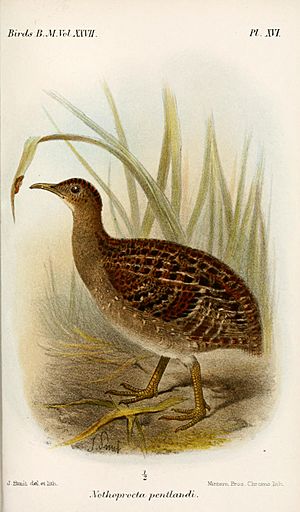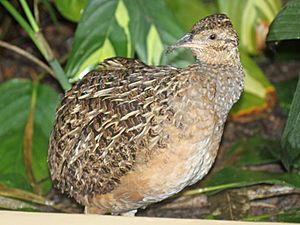Andean tinamou facts for kids
Quick facts for kids Andean tinamou |
|
|---|---|
 |
|
| Illustration by Joseph Smit, 1895 | |
| Conservation status | |
| Scientific classification | |
| Genus: |
Nothoprocta
|
| Species: |
pentlandii
|
| Subspecies | |
|
N. p. pentlandii |
|
 |
|
The Andean tinamou (Nothoprocta pentlandii) is a unique bird found in the Andes mountains of South America. It often lives in high-altitude areas where there are many shrubs and bushes.
Contents
About the Andean Tinamou
All tinamous belong to the bird family called Tinamidae. They are also part of a larger group of birds known as ratites. Other ratites include ostriches and emus, which cannot fly.
Flying Abilities
Unlike most other ratites, tinamous can fly. However, they are not known for being strong or long-distance flyers. Scientists believe that all ratites, including tinamous, evolved from ancient birds that could fly. Tinamous are thought to be the closest living relatives to these prehistoric flying birds.
Naming the Bird
The scientific name pentlandii comes from the Latin form of "Pentland." This name honors Joseph Barclay Pentland, an Irish Traveller who was a geographer and explorer.
Different Types of Andean Tinamou
The Andean tinamou has seven different types, called subspecies. These subspecies are slightly different from each other and live in various parts of the Andes:
- N. p. pentlandii: This type lives in the Andes of western Bolivia, northwestern Argentina, and the very northern part of Chile.
- N. p. ambigua: You can find this subspecies in the Andes of southern Ecuador and northwestern Peru.
- N. p. oustaleti: This one lives on the western slopes of the Andes in central and southern Peru.
- N. p. niethammeri: This type is found along the coast of central Peru.
- N. p. fulvescens: This subspecies lives in the Andes of southeastern Peru.
- N. p. doeringi: This type is found in the Sierras de Córdoba in San Luis and Córdoba Provinces, Argentina.
- N. p. mendozae: This subspecies lives in the Andes of west-central Argentina, specifically in Neuquén and Mendoza Provinces.
What the Andean Tinamou Looks Like
The Andean tinamou is about 27 centimeters (11 inches) long. Its upper body is greyish-brown to olive-brown. It has stripes of black and white across its back.
Body Features
Its chest is grey and has white or buff spots. The belly is usually buff or whitish. The top of its head, called the crown, is black. The sides of its head and its throat have mottled grey patterns. The legs of the Andean tinamou are yellow.
Where the Andean Tinamou Lives
The Andean tinamou can be found in the Andes mountain range. Its home stretches from southern Ecuador all the way to central Chile. It also lives in the Sierras de Córdoba in Argentina.
Preferred Habitat
This bird prefers to live in subtropical and tropical shrubland. It likes areas that are quite high up, usually between 800 and 4,100 meters (2,600 to 13,500 feet) above sea level.
Protecting the Andean Tinamou
The IUCN (International Union for Conservation of Nature) keeps track of how many Andean tinamous there are. They classify this bird as "Least Concern." This means that the species is not currently at risk of disappearing.
Population and Range
The Andean tinamou lives across a very large area. Its habitat covers about 550,000 square kilometers (210,000 square miles). This wide range helps the species stay healthy and not become endangered.
See also
 In Spanish: Perdiz andina para niños
In Spanish: Perdiz andina para niños



